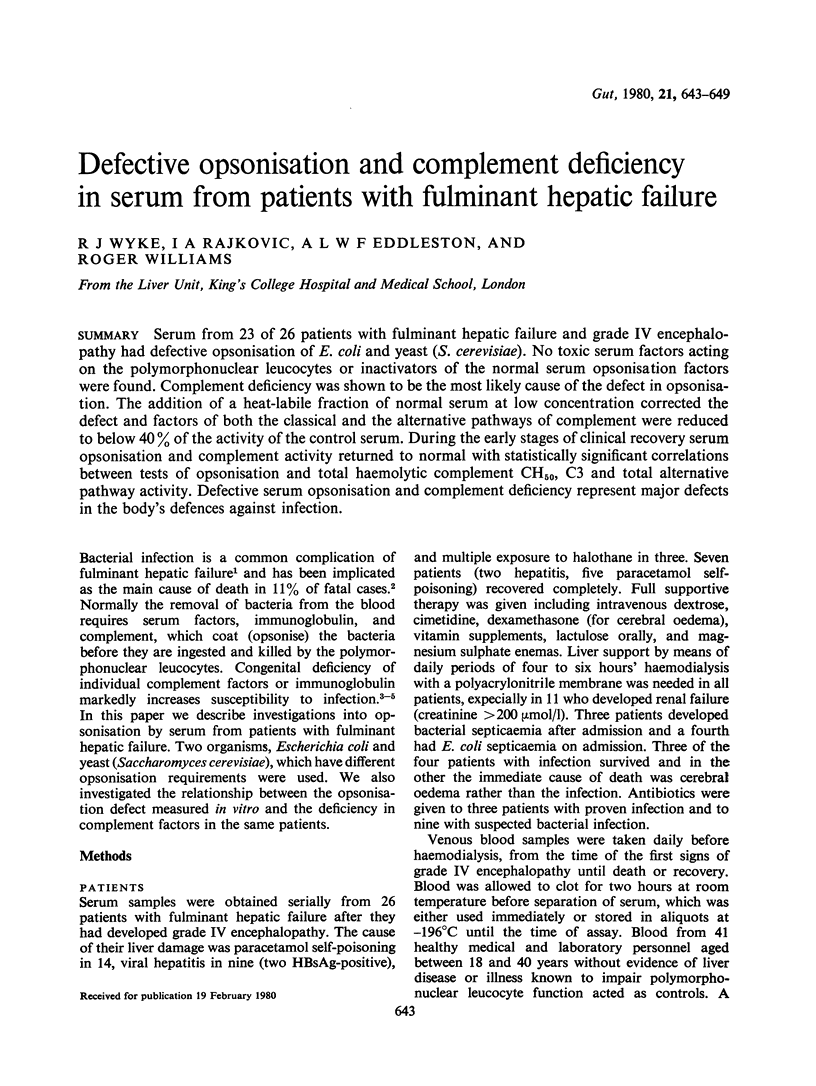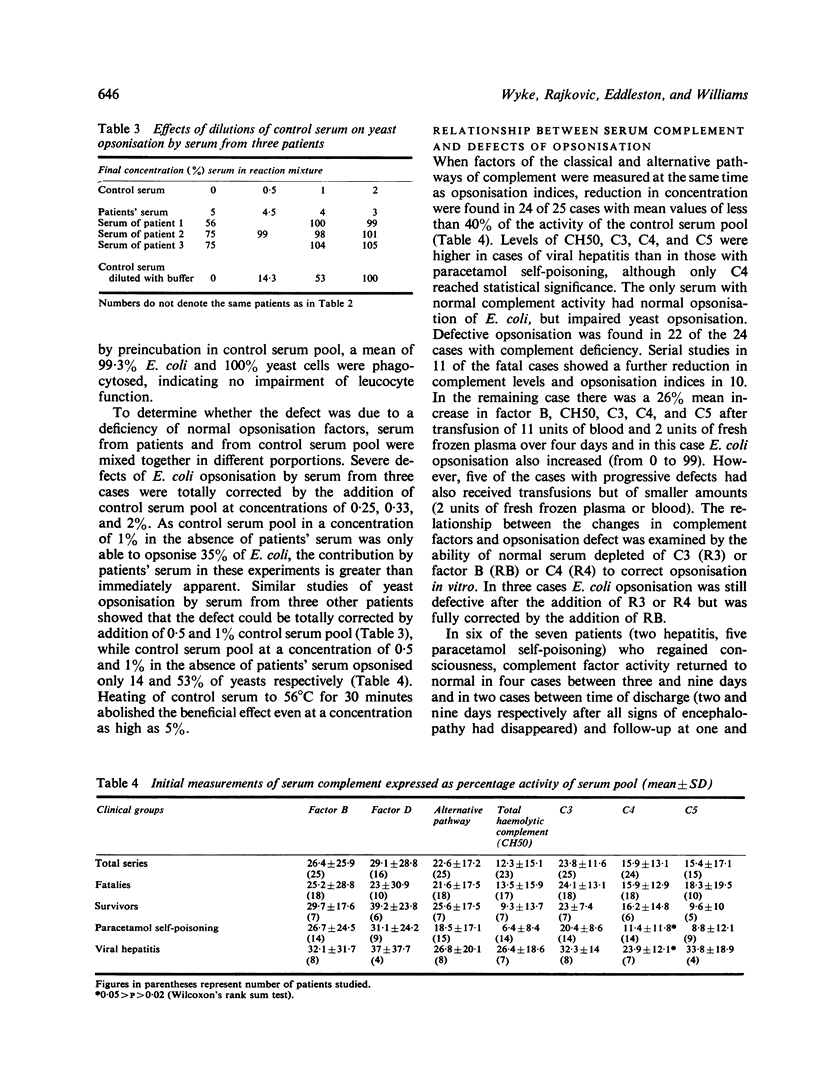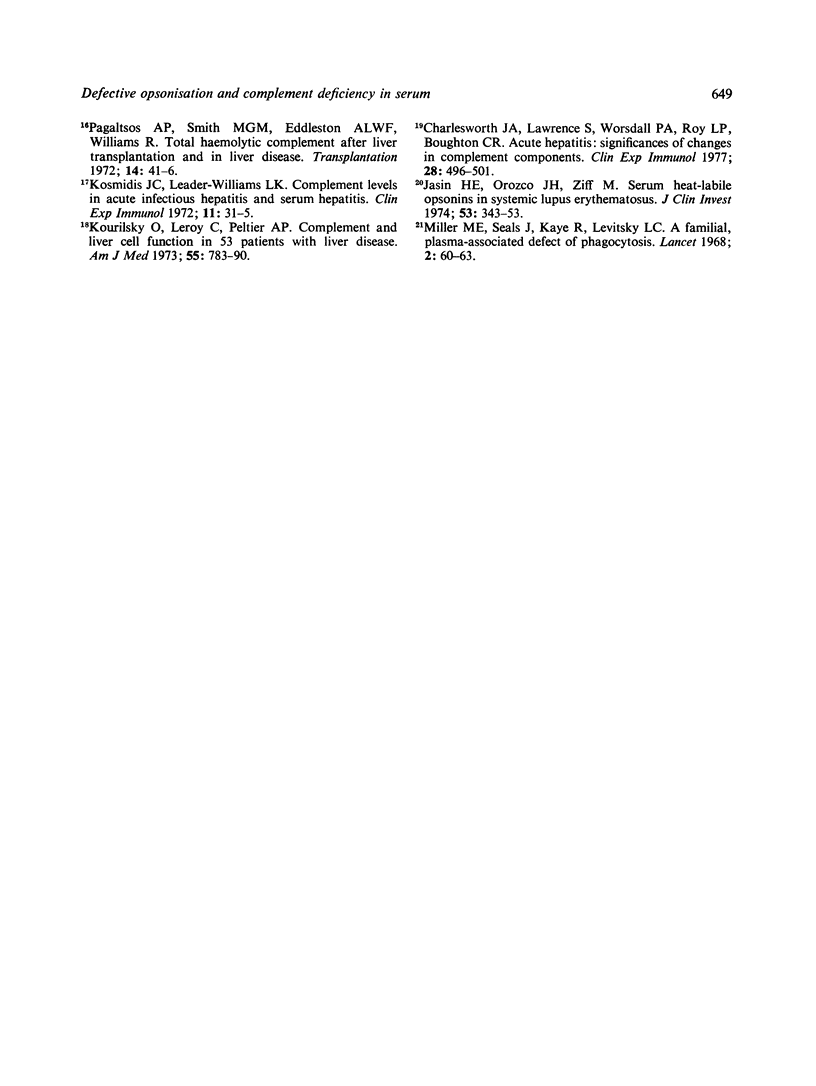Abstract
Serum from 23 of 26 patients with fulminant hepatic failure and grade IV encephalopathy had defective opsonisation of E. coli and yeast (S. cerevisiae). No toxic serum factors acting on the polymorphonuclear leucocytes or inactivators of the normal serum opsonisation factors were found. Complement deficiency was shown to be the most likely cause of the defect in opsonisation. The addition of a heat-labile fraction of normal serum at low concentration corrected the defect and factors of both the classical and the alternative pathways of complement were reduced to below 40% of the activity of the control serum. During the early stages of clinical recovery serum opsonisation and complement activity returned to normal with statistically significant correlations between tests of opsonisation and total haemolytic complement CH50, C3 and total alternative pathway activity. Defective serum opsonisation and complement deficiency represent major defects in the body's defences against infection.
Full text
PDF






Selected References
These references are in PubMed. This may not be the complete list of references from this article.
- Abramson N., Alper C. A., Lachmann P. J., Rosen F. S., Jandl J. H. Deficiency of C3 inactivator in man. J Immunol. 1971 Jul;107(1):19–27. [PubMed] [Google Scholar]
- Alam A. N., Poston L., Wilkinson S. P., Golindano C. G., Williams R. A study in vitro of the sodium pump in fulminant hepatic failure. Clin Sci Mol Med. 1978 Oct;55(4):355–363. doi: 10.1042/cs0550355. [DOI] [PubMed] [Google Scholar]
- Alper C. A., Colten H. R., Rosen F. S., Rabson A. R., Macnab G. M., Gear J. S. Homozygous deficiency of C3 in a patient with repeated infections. Lancet. 1972 Dec 2;2(7788):1179–1181. doi: 10.1016/s0140-6736(72)92598-6. [DOI] [PubMed] [Google Scholar]
- Bailey R. J., Woolf I. L., Cullens H., Williams R. Metabolic inhibition of polymorphonuclear leucocytes in fulminant hepatic failure. Lancet. 1976 May 29;1(7970):1162–1163. doi: 10.1016/s0140-6736(76)91546-4. [DOI] [PubMed] [Google Scholar]
- Charlesworth J. A., Lawrence S., Worsdall P. A., Roy L. P., Boughton C. R. Acute hepatitis: significance of changes in complement components. Clin Exp Immunol. 1977 Jun;28(3):496–501. [PMC free article] [PubMed] [Google Scholar]
- Clark R. A., Klebanoff S. J. Role of the classical and alternative complement pathways in chemotaxis and opsonization: studies of human serum deficient in C4. J Immunol. 1978 Apr;120(4):1102–1108. [PubMed] [Google Scholar]
- Gazzard B. G., Portmann B., Murray-Lyon I. M., Williams R. Causes of death in fulminant hepatic failure and relationship to quantitative histological assessment of parenchymal damage. Q J Med. 1975 Oct;44(176):615–626. [PubMed] [Google Scholar]
- Jasin H. E., Orozco J. H., Ziff M. Serum heat-labile opsonins in systemic lupus erythematosus. J Clin Invest. 1974 Feb;53(2):343–353. doi: 10.1172/JCI107566. [DOI] [PMC free article] [PubMed] [Google Scholar]
- Kourilsky O., Leroy C., Peltier A. P. Complement and liver cell function in 53 patients with liver disease. Am J Med. 1973 Dec;55(6):783–790. doi: 10.1016/0002-9343(73)90259-3. [DOI] [PubMed] [Google Scholar]
- Levinsky R. J., Harvey B. A., Paleja S. A rapid objective method for measuring the yeast opsonisation activity of serum. J Immunol Methods. 1978;24(3-4):251–256. doi: 10.1016/0022-1759(78)90129-1. [DOI] [PubMed] [Google Scholar]
- Martin A., Lachmann P. J., Halbwachs L., Hobart M. J. Haemolytic diffusion plate assays for factors B and D of the alternative pathway of complement activation. Immunochemistry. 1976 Apr;13(4):317–324. doi: 10.1016/0019-2791(76)90341-4. [DOI] [PubMed] [Google Scholar]
- Mummery R. V., Bradley J. M., Jeffries D. J. Microbiological monitoring of patients in hepatic failure with particular reference to extracorporeal porcine liver perfusion. Lancet. 1971 Jul 10;2(7715):60–64. doi: 10.1016/s0140-6736(71)92042-3. [DOI] [PubMed] [Google Scholar]
- Pagaltsos A. P., Smith M. G., Eddleston A. L., Williams R. Total haemolytic complement after liver transplantation and in liver disease. Transplantation. 1972 Jul;14(1):41–46. doi: 10.1097/00007890-197207000-00006. [DOI] [PubMed] [Google Scholar]
- Quie P. G., White J. G., Holmes B., Good R. A. In vitro bactericidal capacity of human polymorphonuclear leukocytes: diminished activity in chronic granulomatous disease of childhood. J Clin Invest. 1967 Apr;46(4):668–679. doi: 10.1172/JCI105568. [DOI] [PMC free article] [PubMed] [Google Scholar]
- Saunders S. J., Dowdle E. B., Fiskerstrand C., Bassendine M., Walls R. Serum factor affecting neutrophil function during acute viral hepatitis. Gut. 1978 Oct;19(10):930–934. doi: 10.1136/gut.19.10.930. [DOI] [PMC free article] [PubMed] [Google Scholar]
- Soothill J. F., Harvey B. A. A defect of the alternative pathway of complement. Clin Exp Immunol. 1977 Jan;27(1):30–33. [PMC free article] [PubMed] [Google Scholar]
- Van Oss C. J., Gillman C. F. Phagocytosis as a surface phenomenon. II. Contact angles and phagocytosis of encapsulated bacteria before and after opsonization by specific antiserum and complement. J Reticuloendothel Soc. 1972 Nov;12(5):497–502. [PubMed] [Google Scholar]
- Vierucci A., London W. T., De Martino M., Blumberg B. S. Neutrophil function in children who are carriers of hepatitis-B surface antigen. Lancet. 1977 Jan 22;1(8004):157–160. doi: 10.1016/s0140-6736(77)91761-5. [DOI] [PubMed] [Google Scholar]


